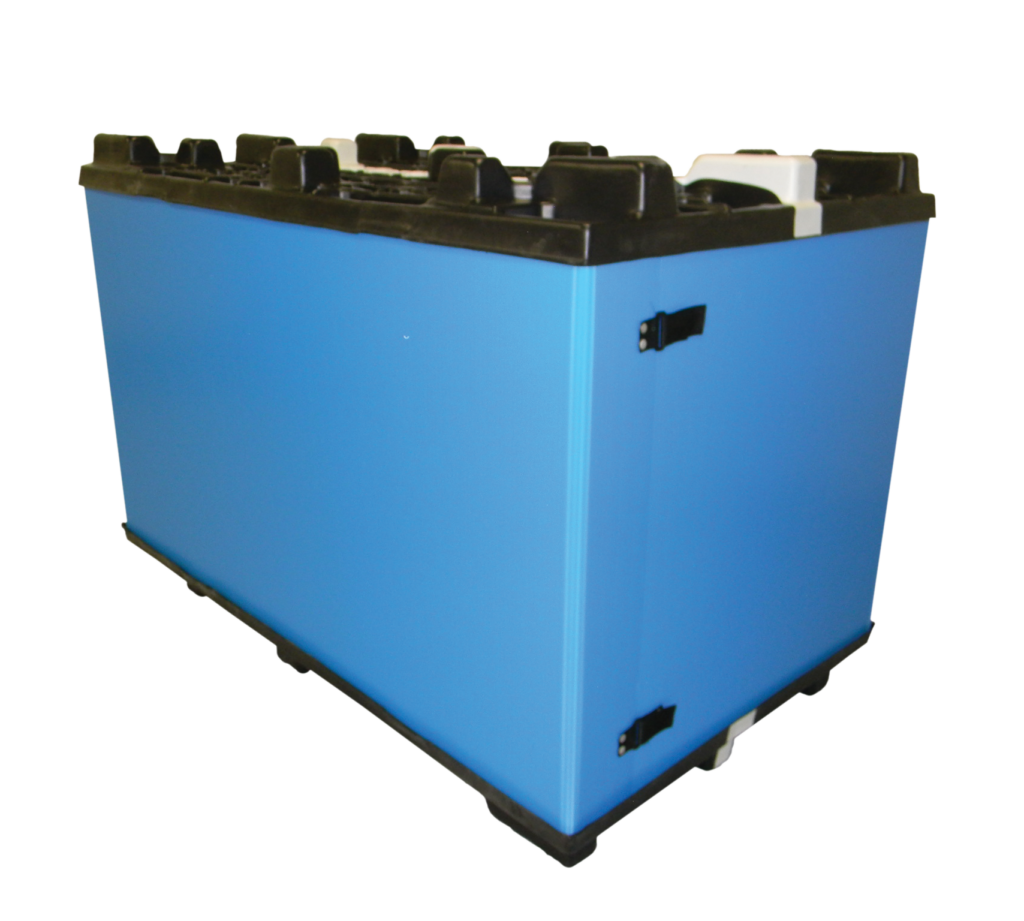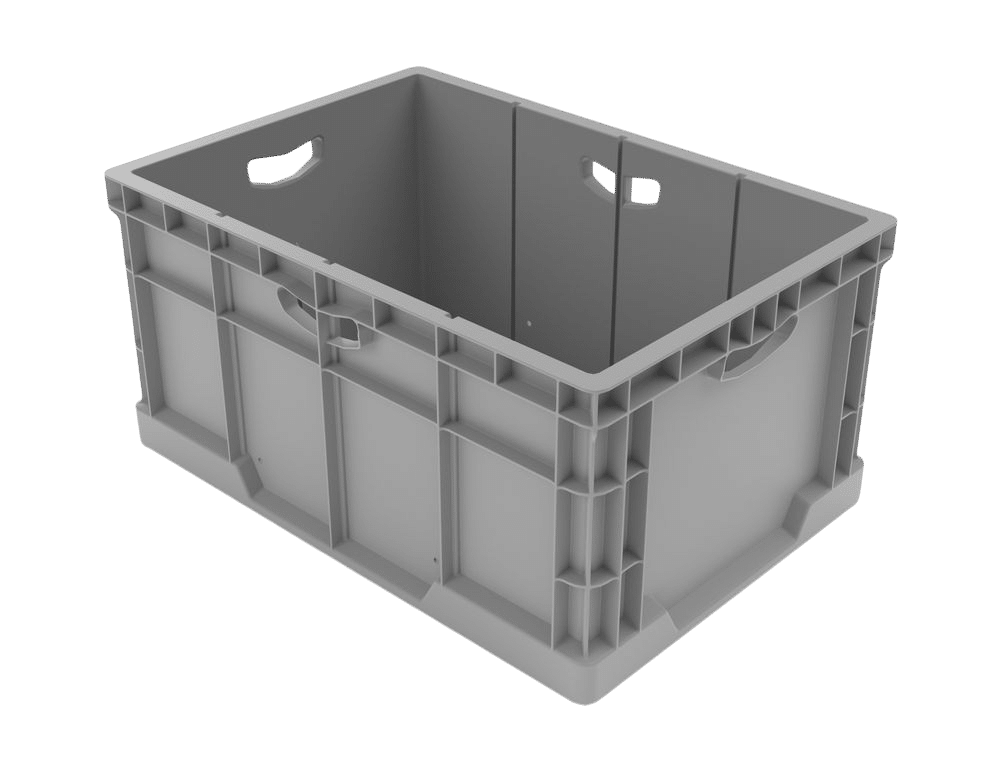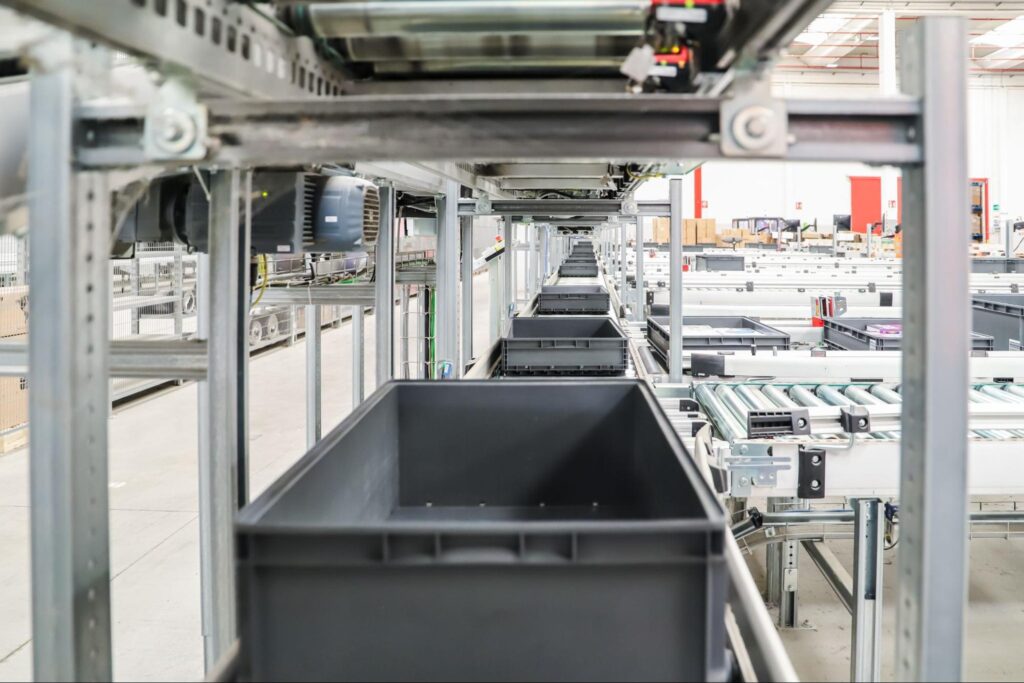In today’s competitive market, returnable packaging has become a valuable consideration for companies seeking to boost efficiency, manage operational costs over the long term, and pursue sustainability goals. As ROI-focused packaging strategies demonstrate, adopting durable, reusable systems can potentially reduce waste and lead to cost efficiencies over time.
This article provides a focused guide on how to justify investments in returnable packaging by presenting clear financial metrics, strategic benefits, and risk management advantages to C-suite stakeholders.
Why Returnable Packaging Is a C-Suite Priority
Returnable packaging is more than an operational tweak—it represents a strategic investment with multiple potential benefits. Transitioning from disposable packaging to durable, reusable systems can help reduce waste and may lead to cost savings over the long term. When presented as an initiative that may drive long-term cost efficiency, mitigate certain risks, and support sustainability standards, returnable packaging shifts from being perceived as a routine expense to a strategic consideration for the C-suite.
The C-Suite Mindset: Overcoming Barriers to Capital Investment
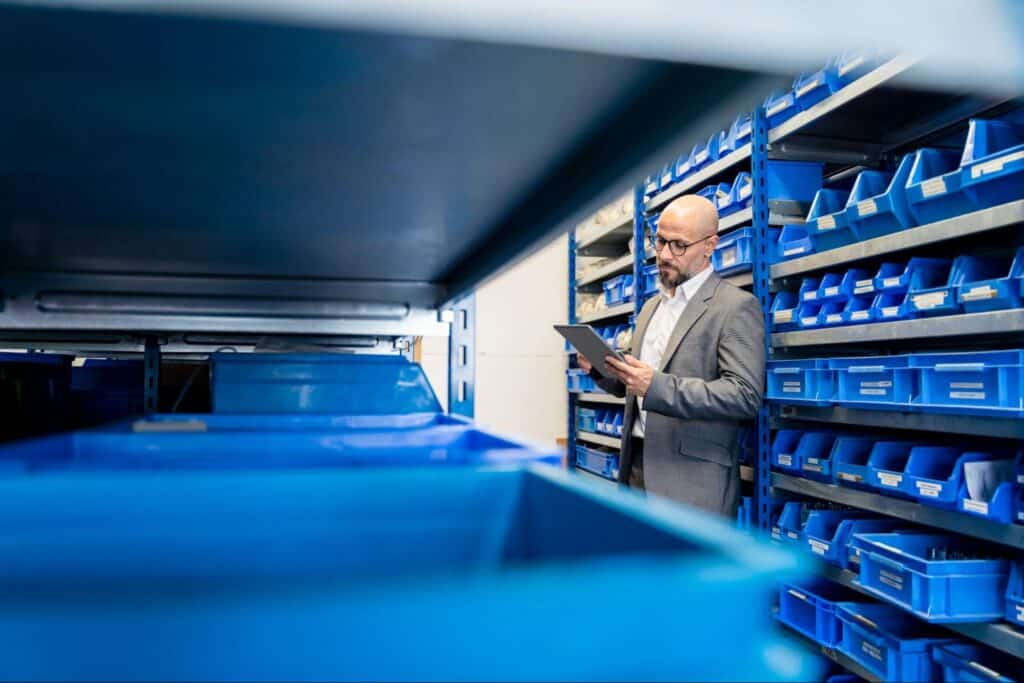
Securing C-suite approval often means addressing concerns about cash flow, short-term expenses, and the perception of packaging as a non-critical cost. Executives may be reluctant to allocate capital for initiatives seen merely as operational necessities rather than revenue drivers. To address these concerns, it is essential to reframe the discussion.
Highlight that returnable packaging can lower recurring costs associated with disposable materials and waste management. Additionally, while its impact on improving supply chain reliability is not universally confirmed, there is evidence suggesting that standardizing packaging practices can offer benefits in consistency and logistical efficiency. By aligning the discussion with broader strategic priorities—such as risk reduction, regulatory compliance, and sustainability—procurement professionals can reposition the investment as a forward-thinking enhancement rather than a mere cost.
Quantifying Value: Metrics That Matter to CFOs
Financial evidence is key when pitching any capital investment. For CFOs and other financial decision-makers, presenting ROI and cost savings in a data-driven manner creates a persuasive case. Focus on these core metrics:
- CapEx vs. OpEx Comparison: Emphasize that while returnable packaging requires an upfront capital investment, it has the potential to reduce ongoing operational expenses over time by diminishing the recurring need for disposable materials.
- Payback Period: Provide a clear timeline over which the investment is expected to begin paying for itself. Outline how cost savings may accumulate from reduced material consumption, lower waste disposal fees, and fewer losses from product damage.
- Lifecycle Cost Analysis: Present a detailed cost breakdown that considers acquisition, maintenance, and eventual disposal or recycling. Comparing these long-term costs with those of one-time disposable options can underline the prospective economic benefits.
- Operational Efficiency Gains: Quantify improvements, such as faster handling times and fewer incidents of product damage. Some case studies, such as those presented by the Reusable Packaging Association (RPA), indicate that a shift to reusable systems can potentially reduce downtime and labor costs, contributing to smoother operations.
By presenting these metrics clearly, decision-makers can evaluate how returnable packaging not only offers potential cost savings through reduced waste and material usage but also supports long-term financial planning.
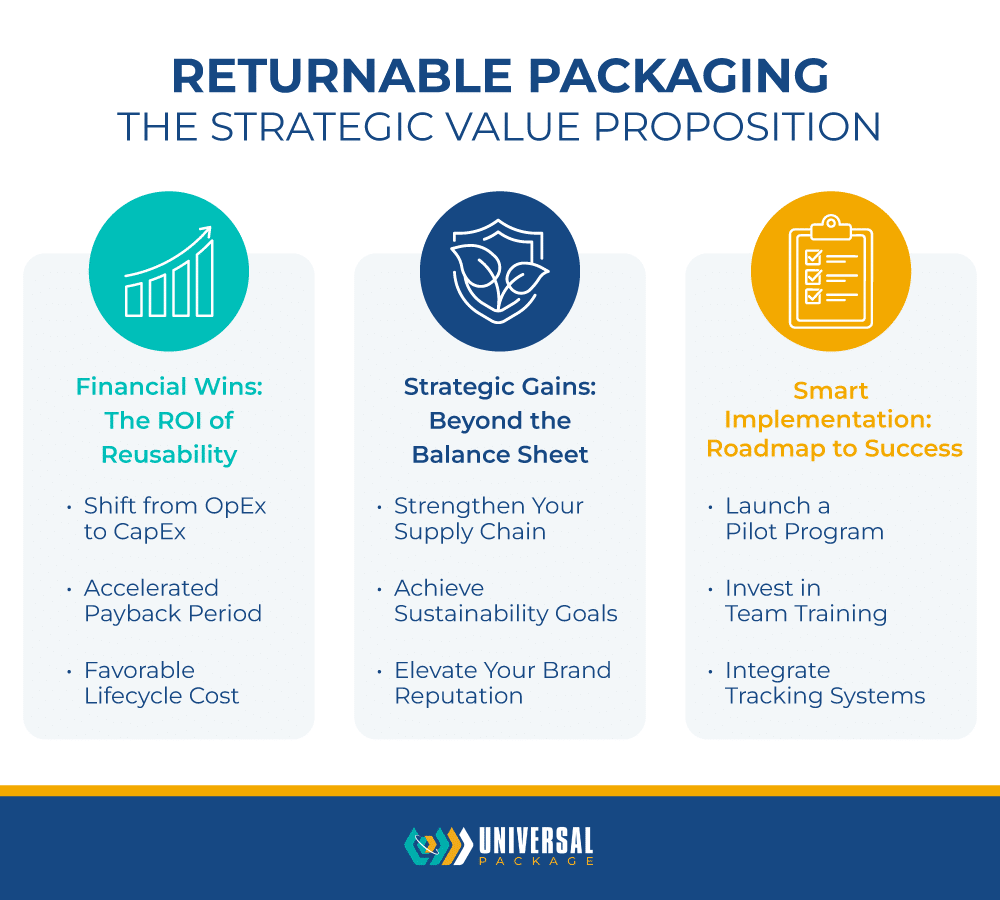
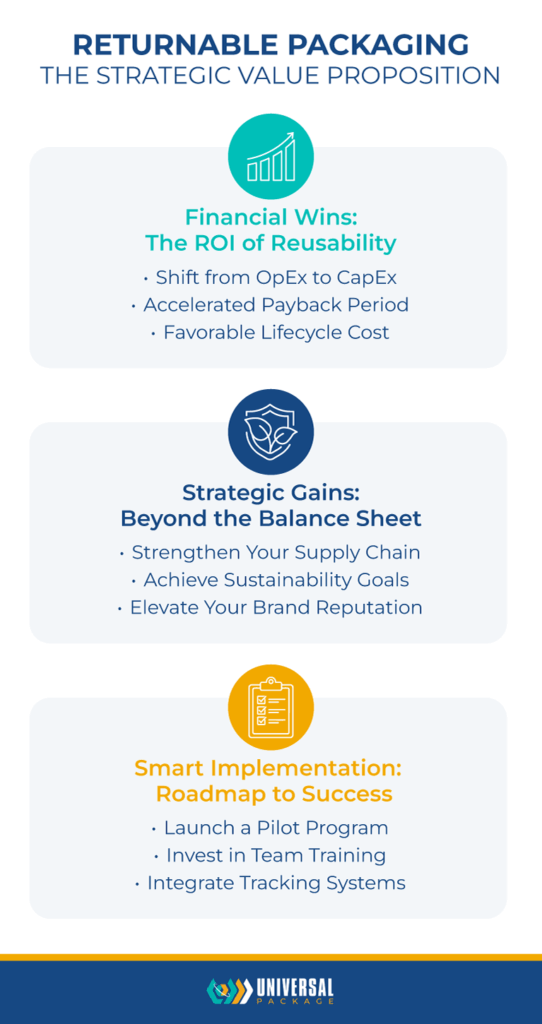
Beyond Dollars: Strategic Value and Competitive Advantage
While cost savings are fundamental, returnable packaging can also offer additional strategic benefits that resonate with executives:
- Contributing to Supply Chain Management: Durable, reusable packaging may help lessen the dependency on continuously procuring single-use items, which can support a more consistent supply chain. Although the evidence linking this approach directly to enhanced supply chain resilience is less robust, the standardized nature of returnable systems can foster improvements in logistics coordination.
- Advancing Sustainability and Compliance: The environmental benefits of reusing packaging extend beyond immediate cost considerations. By reducing waste and, over time, lowering cumulative greenhouse gas emissions, companies can more easily meet sustainability mandates and compliance requirements. Guidance from organizations such as The Sustainable Packaging Coalition and insights from U.S. Environmental Protection Agency guidelines underline the importance of eco-friendly practices for modern businesses.
- Enhancing Corporate Reputation: In an era when sustainability is increasingly valued by consumers, adopting eco-friendly practices like returnable packaging can improve a company’s brand image. Demonstrating a commitment to environmental stewardship can be a decisive advantage when engaging with stakeholders and securing new business opportunities.
By combining potential cost efficiencies with strategic environmental benefits, returnable packaging presents itself as a comprehensive solution that addresses both short-term financial concerns and long-term competitive positioning.
Managing Risk, Ensuring Compliance, and Future-Proofing Operations
Investing in returnable packaging also provides several risk management benefits. Companies face varied challenges—from supply chain disruptions to regulatory changes—and a robust packaging system can help mitigate some of these risks.
- Mitigating Supply Chain Risks: Returnable packaging offers consistent performance by reducing the frequent need to repurchase disposable alternatives. Implementing a standardized system can lessen risks associated with material shortages and quality variations.
- Regulatory Compliance and Environmental Mandates: Many industries are subject to stringent environmental regulations that require effective waste management. Transitioning to reusable packaging not only helps companies address these mandates but also positions them as proactive market leaders in sustainability.
- Future-Proofing Against Market Changes: As consumer expectations evolve and regulations continue to develop, companies must adapt to maintain operational agility. Returnable packaging is designed to be scalable, potentially growing with a business and offering the flexibility to respond to future challenges. For further exploration of risk mitigation strategies, review Lease & Rental Options provided by Universal Package.
Incorporating risk management and future-proofing into the investment narrative reinforces the idea that the benefits of returnable packaging extend well beyond immediate cost reductions, establishing a more stable foundation for long-term growth.
From Plan to Action: A Practical Implementation Roadmap
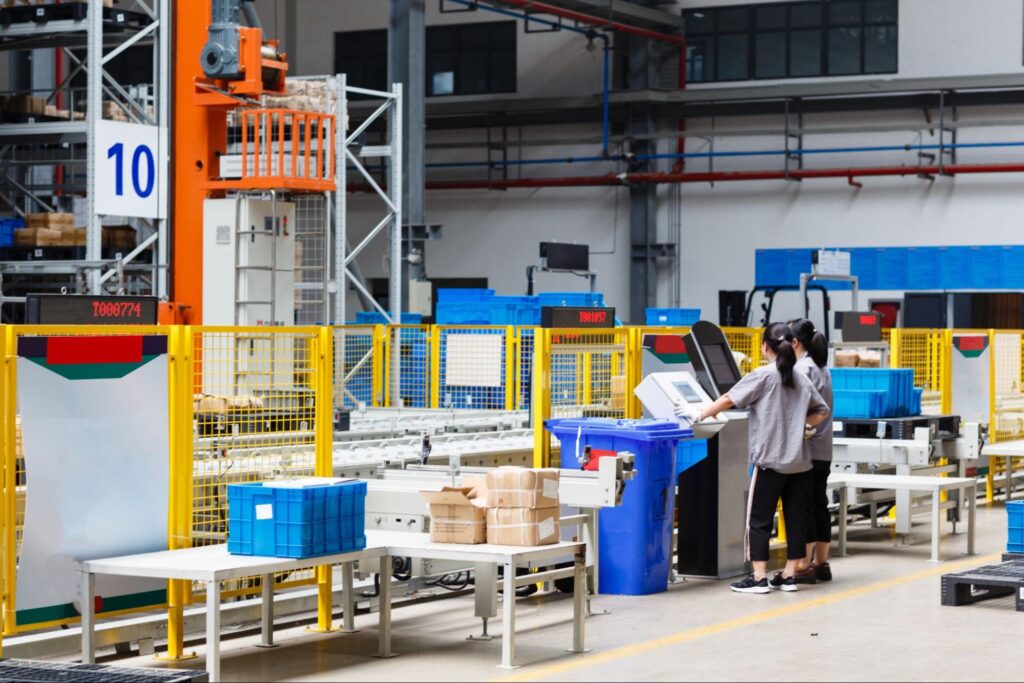
A successful transition to returnable packaging is not an overnight switch but a carefully managed process. To de-risk the investment and ensure a smooth rollout, a phased approach that addresses the key operational shifts required for success should be proposed.
1. Validate the Concept with a Pilot Program
Before a full-scale rollout, recommend launching a targeted pilot program on a specific product line or shipping loop. This low-risk approach allows us to:
- Gather real-world data to validate the projected ROI and payback period.
- Test packaging durability and performance in the operational environment.
- Identify and resolve potential bottlenecks in the workflow on a small, manageable scale.
2. Ensure Seamless Adoption Through Employee Training
The success of a returnable system hinges on proper handling. A clear training module would be developed to ensure employees understand the new processes for packing, handling, and returning the packaging. This small investment in training is critical to protect the larger capital investment by maximizing the lifespan of the assets and maintaining operational efficiency.
3. Implement Robust Tracking and Logistics
To protect the investment, a clear system for tracking the packaging assets is essential. This can range from simple barcode scanning to more advanced RFID technology, depending on the scale of the operation. The goal is to maintain asset visibility, minimize loss, and ensure a high-functioning closed-loop system for returns. This also includes establishing a clear and efficient reverse logistics process to get the packaging back into circulation quickly.
Financial Metrics and Strategic Positioning in Returnable Packaging
Returnable packaging offers a promising opportunity for companies aiming to secure long-term efficiencies, optimize operational processes, and advance sustainability standards. By clearly presenting financial metrics—through CapEx vs. OpEx comparisons, payback periods, and lifecycle cost analyses—and by highlighting potential strategic benefits such as moderated waste levels and improved logistics, procurement leaders can articulate a compelling case to the C-suite.
Take the next step by evaluating your current packaging strategy and identifying opportunities to transition. Contact Universal Package for expert consultation and tailored solutions that help unlock the combined financial and strategic potential of returnable packaging. Embrace a future where operational efficiency and environmental stewardship work hand in hand, and make an investment that is both measured and transformative.


